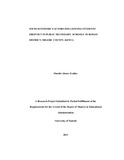| dc.description.abstract | The study was undertaken to investigate the socio-economic factors
influencing public secondary school students’ dropout in Rongo District.
The study sought to determine the influence of peer pressure, family
headship, parents’ financial status on students’ dropout in Rongo district.
The study also sought to establish the strategies used by the head teachers
in retention of secondary school students. The statement of the problem
showed that the district had a dropout rate of 43 percent as compared to
the neighboring districts like Uriri, Awendo, Nyatike, Kuria and Migori
which had the following percentages 25, 9, 27, 23 and 28 despite the
similar government’s strategies availed to all the public secondary schools
and the coverage of the same syllabus throughout the country. The study
therefore sought to unearth the underlying factors leading to the high
dropout rate.
The study was confined to public secondary schools in Rongo District
focusing on form 3 and 4 as they have been in school long enough to
understand the schooling process. The descriptive design which involved
qualitative strategies to data collection was employed. A total number of
755 pupils, teachers and head teachers were targeted for the study. A
sample of 235 respondents was identified as follows, 200 students, 20
principals and 15 class teachers. Both probability and non-probability
sampling techniques were used for various respondents. Data collection
was done using questionnaires and interview schedules as the main
research instruments.
The data was analyzed using frequencies and percentages presented in
tables and discussed as per the literature review in chapter two. A cross
tabulation design was used to establish the findings and revealed that peer
pressure influenced student drop out with 43.75%, family headship with
50%, parent financial status with 81.25% and finally principal’s strategies
like the formation of guidance and counseling departments and motivation
of students contributed in students’ retention. High dropout was as a result
of parent/ guardian financial status and family headship which lead to
inadequate guidance/ mentorship to the students. Poverty was critical as it
led to inadequate school supplies and neglect of school activities like
attending the parent/guardian meetings when invited by the school.
The study concluded that in most cases where students are most often sent
home there are high chances that some never returned to school and most
schools did not support the learners who were coming from poor
background. It can therefore be concluded that socio-economic factors
highly influence the retention of students in secondary school.
xiii
Recommendations noted for the study called for the collaborative efforts
by the government and other education stakeholders to support and provide for the learners who cannot afford the rising financial conditions
of learning. Guidance and counseling, close interactions with the teachers
by the students, proper syllabus content delivery are other measures to be
upheld. Performance reward should be effective to aid in motivation of
both the teachers and the students. The Ministry of Education should
ensure proper dissemination plan covering the head teachers, teachers,
pupils and parents. This coupled with close monitoring at the grass root
level should put in place a high level of retention in the implementation
process. The government should employ more teachers to help curb the
discrepancies of teacher students’ ratio. Further research should be done
on the effects of student stress on their (student) performance, the
influence of student’s environmental background on their retention and the
extent to which student motivation influence their retention | en |

